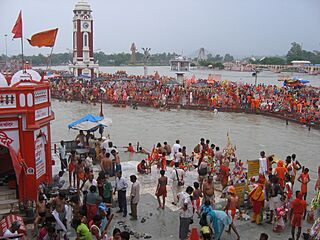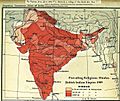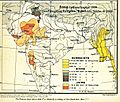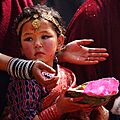Hindus facts for kids
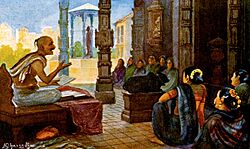
Early-20th-century painting by M. V. Dhurandhar of Hindu devotees in satsanga and listening to the pravachana of the Puranas
|
|
| Total population | |
|---|---|
| 1.2 billion worldwide (2023) (15% of the global's population) |
|
| Regions with significant populations | |
| India | 1,106,000,000 |
| Nepal | 28,600,000 |
| Bangladesh | 13,130,102 |
| Indonesia | 4,646,357 |
| Pakistan | 4,444,870 |
| United States | 3,230,000 |
| Sri Lanka | 3,090,000 |
| Malaysia | 1,949,850 |
| United Arab Emirates | 1,239,610 |
| United Kingdom | 1,030,000 |
| Canada | 828,100 |
| Australia | 684,000 |
| Mauritius | 670,327 |
| South Africa | 505,000 |
| Saudi Arabia | 451,347 |
| Singapore | 280,000 |
| Fiji | 261,136 |
| Myanmar | 252,763 |
| Trinidad and Tobago | 240,100 |
| Guyana | 190,966 |
| Bhutan | 185,700 |
| Italy | 180,000 |
| Netherlands | 160,000 |
| France | 150,000 |
| Russia | 143,000 |
| Suriname | 128,995 |
| New Zealand | 123,534 |
| Religions | |
| Hinduism (Sanātana Dharma)
|
|
| Scriptures | |
|
|
| Languages | |
|
|
Hindus are people who follow Hinduism, which is also called Sanātana Dharma. The word "Hindu" has been used for a long time to describe people living in the Indian subcontinent. It also refers to their culture and religion.
Today, there are about 1.2 billion Hindus worldwide. This makes them the third-largest religious group after Christians and Muslims. Most Hindus, about 94%, live in India. Other countries with large Hindu populations include Nepal, Bangladesh, Indonesia, and the United States.
Contents
What Does "Hindu" Mean?
The word Hindu comes from the ancient Sanskrit word Sindhu. This word means "a large body of water," like a river or ocean. It was first used for the Indus River. People living beyond this river were called "Hindu" by Persians. So, originally, it was a geographical term.
Over time, the meaning of "Hindu" changed. By the 16th century, it started to describe people in India who were not Muslims. Later, during the British colonial era, the term "Hindu" was used more widely for people following Indian religions.
How the Term "Hindu" Evolved
In the 7th century CE, a Chinese Buddhist scholar named Xuanzang used a term similar to "Hindu" with a religious meaning. Later, in the 11th century, scholar Al-Biruni used "Hindu" to mean non-Islamic people, including Buddhists.
During the Mughal Empire, the term "Hindu" was used to describe non-Muslims. For example, Emperor Jahangir called the Sikh Guru Arjan a Hindu. This shows that Sikhs were seen as non-Muslim Indians at that time.
"Hindu" in Modern Times
Today, a Hindu is someone who identifies with Hinduism. This includes people who practice the religion and those who feel culturally Hindu. You don't have to be very religious to call yourself a Hindu.
Hindus have many different beliefs and traditions. There isn't one single prophet, holy book, or governing body. Hindus can believe in many gods, one god, or even be agnostic or atheist. Hinduism is often described as a "way of life" because it's so diverse.
Hindus share some core ideas like dharma (right conduct), karma (actions and their results), moksha (liberation), and samsara (the cycle of rebirth). They also share sacred texts like the Vedas and common rituals, such as those for weddings or cremations. Many Hindus go on pilgrimages to holy sites, practice bhakti (devotion), and celebrate festivals like Holi and Diwali.

When Hindus worship, they might focus on a statue, a photograph, or even nature. For many, these images represent a spiritual truth, not just a stone or picture.
Hindu Identity and Other Indian Religions
In India's laws, the word "Hindu" has sometimes included people who follow Jainism, Buddhism, or Sikhism. However, these are distinct religions. For example, the Supreme Court of India has recognized Jainism as a separate religion.
Historically, there were many overlaps between these religions. Jains might worship Hindu gods, and marriages between Jains and Hindus were common. In places like Indonesia, Hinduism and Buddhism sometimes blended together. Sikhs also have strong connections to Hindus, and many Sikh families have Hindu roots.
History of Hindu Identity
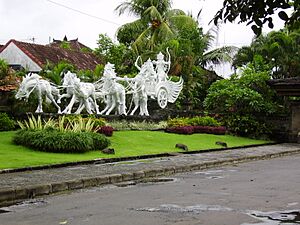
After the 10th century, especially with invasions from Muslim armies, a stronger Hindu identity began to form. People started to connect their religious beliefs with their political identity. For example, some kings were described using stories from the Hindu epic Ramayana when they fought against invaders.
Medieval texts from India also show a clear difference between Hindus and Muslims. Poets like Vidyapati and Kabir wrote about "Hindu dharma" (Hinduism) and contrasted it with "Turaka dharma" (Islam). This shows that people were becoming more aware of their distinct religious identities.
Hindu Identity and Sacred Places
Hindus have long believed in a sacred geography across the Indian subcontinent. Important pilgrimage sites, like the twelve Jyotirlingas for Shaivism and fifty-one Shaktipithas for Shaktism, are found all over India. These sites are mentioned in ancient texts called the Puranas.
The city of Varanasi, for example, has been a sacred pilgrimage site since at least the 6th century CE. The existence of these widespread holy places and shared religious ideas shows that a strong Hindu community with a common identity existed long ago.
Hindu Persecution
Throughout history, Hindus have faced persecution. This included periods of violence, destruction of temples, and enslavement by some Turk-Mongol Muslim armies. Notable examples include events under rulers like Mahmud of Ghazni and Timur. There were also times of severe persecution, such as under Aurangzeb, who destroyed temples and banned Hindu festivals.
In more recent times, Hindus have faced persecution outside India, for example, in Pakistan and Bangladesh.
Hindu Nationalism
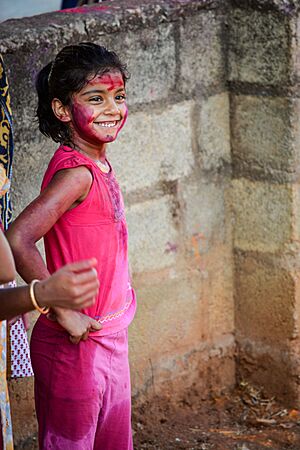
Modern Hindu nationalism began in the 1920s in India. It grew partly as a reaction to some Indian Muslims showing loyalty to the Ottoman Caliph after World War I. Hindus wondered if Indian Muslims were fully committed to an independent India.
Some scholars also link Hindu nationalism to the Maratha Confederacy, which helped Hindus gain freedom from the Mughal empire in many parts of India. This allowed Hindus to practice their diverse beliefs freely and restored holy places.
During the British colonial era, Christian missionaries and Islamic groups tried to convert Hindus. This led to Hindus wanting to protect their spiritual heritage and form organizations to assert their identity. This contributed to the growth of Hindu nationalism in the 1920s.
After India and Pakistan became separate countries in 1947, the Hindu nationalism movement developed the idea of Hindutva. This movement aims to reform Indian laws to apply equally to all citizens, regardless of religion. For example, Hindu nationalists want a uniform legal age for marriage for all girls, which is a debated topic in India.
Demographics

Hindus are a major religious group worldwide, with 1.2 billion followers. About 95% of them live in India.
The top countries with the most Hindus are:
Hindu populations are growing in Asia, Europe, the Americas, Africa, and Oceania. In ancient times, Hindu kingdoms also spread their religion and traditions across Southeast Asia, including Thailand, Burma, Malaysia, Indonesia, and Cambodia.
In Bali, Indonesia, over 3 million Hindus live. Their culture is deeply influenced by Hindu traders who came to the islands long ago. Balinese Hindus also follow the Vedas and Upanishads. They enjoy stories from the Ramayana and Mahabharata through dances and puppet shows. Like Hindus in India, they believe in four goals of human life: dharma (moral living), artha (wealth), kama (joy), and moksha (liberation).
Culture
Hindu culture describes the way of life and identity of Hindus. It includes art, architecture, diet, clothing, and astrology. The culture of India and Hinduism are very closely linked.
Hindu culture has also influenced many parts of Southeast Asia. Other Indian religions like Jainism, Sikhism, and Buddhism have also been deeply influenced by Hinduism.
Images for kids
-
Hindus celebrating Diwali.
See also
 In Spanish: Hindú para niños
In Spanish: Hindú para niños
- History of Hinduism
- List of Hindu empires and dynasties
- Hinduism by country
- Hindu eschatology
- List of Hindu festivals
- Hindu calendar
- Suratrana
- Samskaram
- Diksha
- Sanātanī


